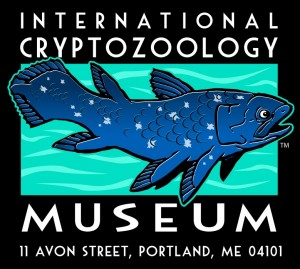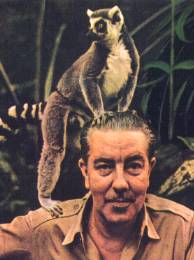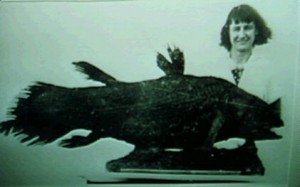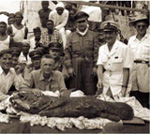
December 2, 2011
A decade ago, I wrote down some thoughts, twelve predictions, which I speculated might come true. I never claimed to be psychic, but I based them on a close reading of the field of cryptozoology, and where I saw this science going as we entered the 21st century. Only one of them (#11), of course, was in my control, so I fostered it until I could see it come to life and reality.
As to the others, well, even H. G. Wells wasn’t right all the time. 🙂
See how I did.
++++
Cryptozoological Predictions for the First Decade of the 21st Century
By Loren Coleman
[This first appeared online at Fortean Times/ January 5, 2001]
(1 January 2001 – 31 December 2010)
(1) Intriguing clues will surface of a new population of coelacanths (those prehistoric-looking fish that were thought to have died out 65 million years ago until they were re-discovered in 1938), far from Africa. Look to the Caribbean, the Gulf of Mexico, or near Australia for some startling news in this regard. More findings from Africa will also occur.
(2) A tropical site will experience a series of remarkable strandings of giant squids, which may include a rare beaching of a “Globster”. [Globsters are large blobs of flesh which have infrequently beached in cryptozoological history (for example, St. Augustine, Florida in 1896, Tasmania 1960, and Bermuda 1988).]
(3) Laser-triggered cameras will capture good photographic evidence of the small unknown anthropoid, the Orang Pendek, in Sumatra. More funding will pour into the specific study and preservation of that primate.
(4) An unpublicized summit between Sasquatch researchers from North America, and Russian, European, Australian, and Asian hominologists will occur in Europe. New standards of cooperation will be a positive outcome of the meeting, but there will be disagreement about how the first discovery of a new large primate should be made.
(5) Post-cranial remains (bones other than from the skull) will be found of Gigantopithecus (a supposedly extinct nine-feet tall ape) in Asia, and many theories regarding the relationship of Gigantopithecus to the Yeti and Bigfoot will have to be revised.
(6) South America will be the source of a thrilling new discovery of a large mammal, possibly of a feline or an animal that looks like a cat although it may be a marsupial.
(7) The search for the Loch Ness Monsters will continue to be frustrating, with no earthshaking findings for another ten years. Awareness that several different kinds of phenomena have been lumped under the Nessie label will increase.
(8) More new mammals will be found in the Lost World of the old Indochina but they will be smaller than the new species of muntjacs (barking deer) and saola (forest goat-bovid) discovered there in the 1990s.
(9) Attention will focus again on searches in Africa. Explorers looking for “living dinosaurs” will find new evidence that the animals being pursued are unknown forest rhinos. Researchers will rediscover the importance of old missionaries’ diaries and records, and scholars will reopen inquiries on these “dinosaurs” as well as spotted lions in Kenya, and unknown apes throughout tropical Africa.
(10) Photographic evidence of an anthropoid in the midwestern/southern part of the United States will archivally be discovered clearly demonstrating a distinct breeding population of great apes separate from the unknown hominoids of the Pacific Northwest. The story of their discovery and the clarity of the photographs will be such that a hoax will be out-of-the question.
11) The International Cryptozoology Museum will open during the decade, and the ICM will become a center for educational scholarship and open sharing in cryptozoology.
(12) Sadly, the world of cryptozoology will be shaken to its foundations by the death of a major founder of the field. Mourning throughout the ranks of cryptozoology will turn into a positive move for a renewed effort and dedication to the combined amateur and academic pursuit of the study of hidden animals. Discussions will occur to pool international resources to support one viable global scientific organization.
© Loren Coleman 2001
Loren Coleman is the author/coauthor of The Field Guide to Bigfoot and Other Mystery Primates and Cryptozoology A to Z, as well as other books. He is the director of the International Cryptozoology Museum, which he founded in 2003, and steered it to nonprofit status in 2011.

The ICM is dedicated to the memories of cryptozoologists and field workers upon whose shoulders all of our study and research is based, including people such as Ivan T. Sanderson, Bernard Heuvelmans, Ruth Harkness, Jack Young, Adelaide “Su-Lin” Young, Quetin Young, Marjorie Courtenay-Latimer, and J.L. Smith.






About Loren Coleman
Loren Coleman is one of the world’s leading cryptozoologists, some say “the” leading living cryptozoologist. Certainly, he is acknowledged as the current living American researcher and writer who has most popularized cryptozoology in the late 20th and early 21st centuries.
Starting his fieldwork and investigations in 1960, after traveling and trekking extensively in pursuit of cryptozoological mysteries, Coleman began writing to share his experiences in 1969. An honorary member of Ivan T. Sanderson’s Society for the Investigation of the Unexplained in the 1970s, Coleman has been bestowed with similar honorary memberships of the North Idaho College Cryptozoology Club in 1983, and in subsequent years, that of the British Columbia Scientific Cryptozoology Club, CryptoSafari International, and other international organizations. He was also a Life Member and Benefactor of the International Society of Cryptozoology (now-defunct).
Loren Coleman’s daily blog, as a member of the Cryptomundo Team, served as an ongoing avenue of communication for the ever-growing body of cryptozoo news from 2005 through 2013. He returned as an infrequent contributor beginning Halloween week of 2015.
Coleman is the founder in 2003, and current director of the International Cryptozoology Museum in Portland, Maine.
Filed under CryptoZoo News, Cryptozoologists, Cryptozoology, Top Ten, Year In Review